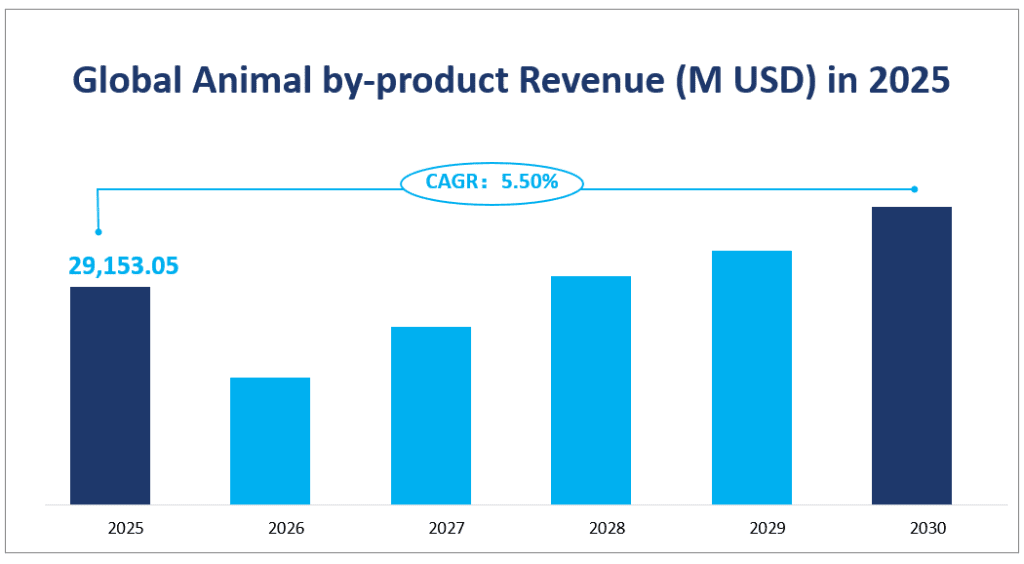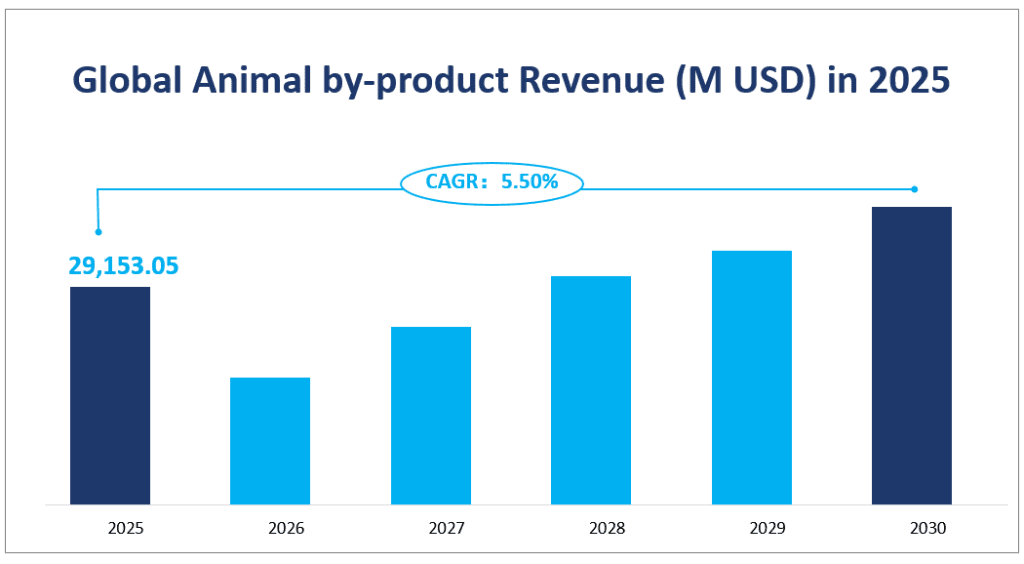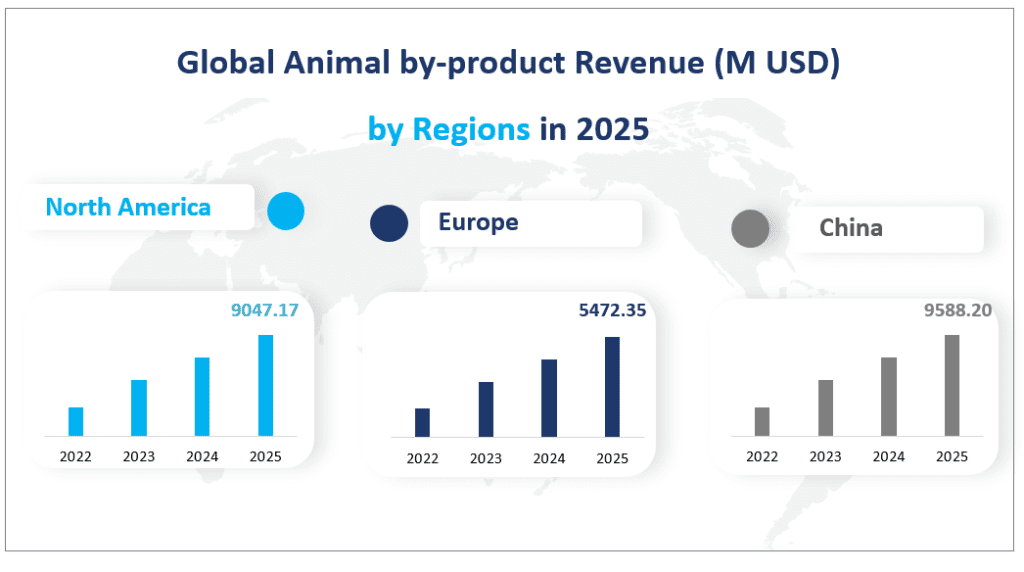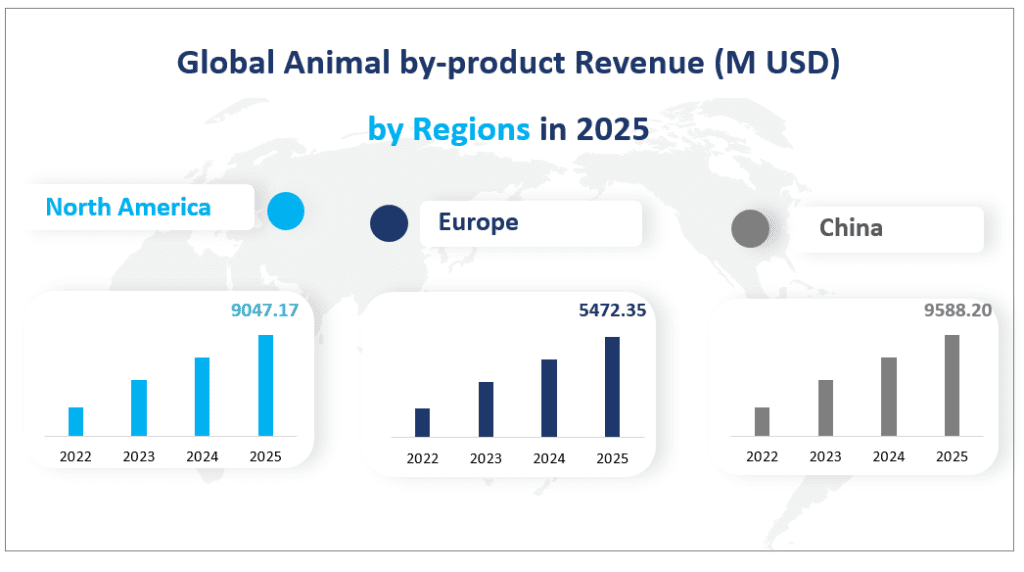1. Global Animal By-product Market Definition
The global Animal By-product market is projected to reach a revenue of $29,153.05 million with a CAGR of 5.50% from 2025 to 2030.
Animal by-products refer to the parts of slaughtered animals that humans do not directly consume. These include meat and bone meal, feather meal, blood meal, and animal fats. These products have high nutritional value and are used in various applications such as animal feed, fertilizers, biofuels, and cosmetics. The versatility and high nutritional content of animal by-products make them valuable resources in multiple industries.
Global Animal by-product Market Revenue (M USD) in 2025


2. Driving Factors of the Animal By-product Market
Several driving factors influence the global Animal By-product market growth. One of the primary drivers is the increasing demand from downstream industries. As the global economy develops and the population continues to grow, the demand for animal by-products in applications such as animal feed, fertilizers, and biofuels is expected to rise. The high nutritional value of these products makes them essential components in animal feed, contributing to the growth of the livestock industry.
Another significant driver of Animal By-product market is the development of new technologies and processes that enhance the efficiency and sustainability of animal by-product market production. Emerging technologies, such as non-thermal processing methods and automation in meat processing, are expected to increase yields, reduce processing time and costs, and produce higher-quality products. These advancements will not only improve the profitability of the industry but also address environmental concerns related to waste management.
3. Limiting Factors of Animal By-product Market
However, the Animal By-product market also faces several limiting factors that could hinder Animal By-product market growth. One of the primary challenges is the potential health risks associated with animal by-products. These products can pose risks to public and animal health if not properly processed and handled. For instance, improper disposal or use of animal by-products can lead to the spread of diseases such as Bovine Spongiform Encephalopathy (BSE) or chemical contamination. Strict regulations and quality control measures are necessary to mitigate these risks, but they can also increase the operational costs for producers.
Another limiting factor is the increasing competition within the animal by-product market. With major manufacturers and suppliers competing globally, the intensity of competition has risen. This competition can lead to price wars and reduced profit margins for established players. Additionally, the entry of small companies and retailers into the market can result in the proliferation of sub-standard products, further complicating the competitive landscape.
4. Global Animal By-product Market Segment
Product Types
Meat and Bone Meal is the largest segment within the Animal By-product market. In 2025, it is expected to generate a revenue of $12,319.57 million. MBM is primarily used in animal feed to improve the amino acid profile and overall nutritional value. Despite its widespread use, MBM has faced regulatory challenges due to its association with Bovine Spongiform Encephalopathy (BSE), which has restricted its use in ruminant feed in many regions. However, its application in monogastric animal feed continues to drive its market presence.
Feather Meal is another important product type, with a projected revenue of $1,035.33 million in 2025. Feather Meal is derived from poultry feathers and is used in animal feed and organic fertilizers. Its high nitrogen content makes it a valuable source of protein for non-ruminant animals. The animal by-product market for Feather Meal is expected to grow steadily, driven by the increasing demand for sustainable and high-protein feed ingredients.
Blood Meal is a nitrogen-rich by-product used in fertilizers and animal feed. In 2025, it is projected to generate a revenue of $1,530.80 million. Blood Meal is particularly valued for its ability to enhance soil fertility and promote plant growth. Its market growth is driven by the increasing demand for organic fertilizers and high-protein feed ingredients. Blood Meal is expected to grow at a significant rate due to its versatile applications and high nutritional value.
Animal Fats are a crucial segment of the Animal By-product market, with a projected revenue of $12,129.97 million in 2025. Animal Fats are used in a variety of applications, including biofuels, lubricants, and animal feed. The growth of the biofuel industry, driven by increasing demand for renewable energy sources, is a key driver for the Animal Fats market. Additionally, the use of animal fats in high-quality feed formulations further supports its market growth.
Market by Applications
Animal Feed is the largest application segment, with a projected revenue of $9,554.46 million in 2025. The use of animal by-products in feed formulations is driven by their high nutritional value and cost-effectiveness. The growing livestock industry and increasing demand for high-protein feed ingredients are key drivers for this segment. The market for animal feed is expected to grow steadily as the global demand for meat and dairy products continues to rise.
The Fertilizer segment is projected to generate a revenue of $2,538.78 million in 2025. Animal by-products such as Blood Meal and Feather Meal are used in organic fertilizers due to their high nitrogen content. The increasing demand for sustainable and organic farming practices is driving the growth of this segment. The market for fertilizers is expected to grow at a significant rate, driven by the need for high-yield and environmentally friendly agricultural practices.
The Chemical Industry segment is expected to generate a revenue of $8,858.88 million in 2025. Animal by-products are used in the production of various chemicals, including biofuels, lubricants, and industrial oils. The growth of the biofuel industry and increasing demand for renewable energy sources are key drivers for this segment. The market for chemicals is expected to grow steadily as the demand for sustainable and high-performance products increases.
The Fuel segment is projected to generate a revenue of $4,014.68 million in 2025. Animal Fats are a key component in the production of biofuels, making this segment a significant contributor to the market revenue. The increasing demand for renewable energy sources and government incentives for biofuel production are driving the growth of this segment. The fuel market is expected to grow at a significant rate as the global focus on sustainable energy solutions continues to increase.
5. Regional Animal By-product Market
North America
North America is projected to generate a revenue of $9047.17 million (USD) in 2025. This region has historically been a major player in the Animal By-product market, driven by a well-established agricultural sector and robust demand from downstream industries such as animal feed and biofuels. The United States and Canada are key markets within this region, with the U.S. being particularly significant due to its large livestock industry and advanced processing technologies. The growth in North America is expected to be steady, supported by ongoing technological advancements and regulatory support for sustainable practices.
Europe
Europe is another significant region in the Animal By-product market, with a projected revenue of $5472.35 million in 2025. The European market is characterized by strong demand for high-quality animal by-products in applications such as fertilizers and biofuels. Countries like Germany, France, and the UK are key contributors to the region’s revenue. The growth in Europe is driven by increasing awareness of sustainability and the need for efficient waste management solutions. The region is also known for its stringent regulations regarding the processing and use of animal by-products, which ensures high-quality products and consumer safety.
China
China is expected to be the fastest-growing region in the Animal By-product market, with a projected revenue of $9588.20 million in 2025. The Chinese market is driven by rapid industrialization, a growing population, and increasing demand for animal by-products in various applications. China’s significant agricultural sector and expanding livestock industry are key factors contributing to its market growth. The country’s focus on sustainable development and the adoption of advanced technologies are also driving the growth of the Animal By-product market in China.
Global Animal by-product Market Revenue (M USD) by Regions in 2025


6. Top 3 Companies in the Animal By-product Market
Company Introduction and Business Overview:
Darling Ingredients is a global leader in creating sustainable food, feed, and fuel solutions from organic by-products. Established in 1882 and headquartered in the USA, Darling Ingredients operates worldwide and is known for its innovative processes and commitment to sustainability. The company collects and repurposes animal-based co-products and other natural materials, reducing food waste and creating value-added products.
Products Offered:
Darling Ingredients offers a wide range of products, including meat and bone meal, feather meal, blood meal, and animal fats. These products are used in various applications such as animal feed, fertilizers, biofuels, and cosmetics. The company’s focus on sustainability and innovation has led to the development of advanced processes that ensure high-quality and environmentally friendly products.
In 2022, Darling Ingredients generated a revenue of $3,635.63 million.
Company Introduction and Business Overview:
SARIA is a leading provider of animal by-products, with a strong presence in the UK and Europe. Established in 1926 and headquartered in Germany, SARIA operates in various sectors associated with the food chain. The company is known for its high-quality products and commitment to environmental control and safety.
Products Offered:
SARIA offers a range of animal by-products, including processed animal proteins (PAP) and tallow. These products are used in applications such as animal feed, fertilizers, and biofuels. SARIA’s focus on research and development has led to the continuous improvement of its products and processes, ensuring compliance with all relevant regulations and standards.
In 2022, SARIA generated a revenue of $1,903.23 million.
Company Introduction and Business Overview:
Sanimax is a leading supplier of animal food ingredients, with a strong presence in North America. Established in 1939 and headquartered in the USA, Sanimax is known for its expertise in reclaiming organic by-products from the agri-food industry and transforming them into valuable industrial ingredients.
Products Offered:
Sanimax offers a range of products, including meat and bone meal, feather meal, and animal fats. These products are used in applications such as animal feed and biofuels. Sanimax’s focus on quality and sustainability has led to the development of advanced processes that ensure high-quality and environmentally friendly products.
In 2022, Sanimax generated a revenue of $777.15 million.
Major Players
| Company Name | Headquarters | Market Distribution |
| Darling Ingredients | USA | Worldwide |
| SARIA | UK | Worldwide |
| Sanimax | USA | Mainly in America |
| MOPAC (JBS) | USA | Mainly in America |
| West Coast Reduction | Canada | Worldwide |
| Leo Group | UK | Worldwide |
| TerramarChile | Chile | Worldwide |
| Patense | Brazil | Mainly in Americas |
| JG Pears | UK | Worldwide |
| ABP Food Group | Ireland | Worldwide |
| PRODIA SAS | France | Mainly in Europe |
| Farol | Brazil | Worldwide |
| Birmingham Hide and Tallow | USA | USA |
1 Animal by-product Market Overview
1.1 Product Overview and Scope of Animal by-product
1.2 Animal by-product Segment by Type
1.2.1 Global Animal by-product Market Size Growth Rate Analysis by Type 2022 VS 2028
1.2.2 Meat and Bone Meal
1.2.3 Feather Meal
1.2.4 Blood Meal
1.2.5 Animal Fats
1.3 Animal by-product Segment by Applications
1.3.1 Animal by-product Consumption Comparison by Application: 2017 VS 2022 VS 2028
1.3.2 Animal by-product Applications
1.4 Global Market Growth Prospects
1.4.1 Global Animal by-product Revenue Estimates and Forecasts (2017-2028)
1.4.2 Global Animal by-product Production Estimates and Forecasts (2017-2028)
1.5 Global Animal by-product Market by Region
1.5.1 Global Animal by-product Market Size Estimates and Forecasts by Region: 2017 VS 2022 VS 2028
1.5.2 North America Animal by-product Estimates and Forecasts (2017-2028)
1.5.3 Europe Animal by-product Estimates and Forecasts (2017-2028)
1.5.4 China Animal by-product Estimates and Forecasts (2017-2028)
1.5.5 Japan Animal by-product Estimates and Forecasts (2017-2028)
2 Market Competition by Manufacturers
2.1 Global Animal by-product Production Market Share by Manufacturer
2.2 Global Animal by-product Revenue Market Share by Manufacturer (2017-2022)
2.3 Animal by-product Market Share by Company Type (Tier 1, Tier 2 and Tier 3)
2.4 Global Animal by-product Average Price by Manufacturers (2017-2022)
2.5 Manufacturers Animal by-product Headquarters and Area Served
2.6 Animal by-product Market Competitive Situation and Trends
2.6.1 Animal by-product Market Concentration Rate
2.6.2 Global Top 5 and Top 10 Players Market Share by Revenue
2.6.3 Mergers & Acquisitions, Expansion
3 Production and Capacity by Region
3.1 Global Production of Animal by-product by Regions (2017-2022)
3.2 Global Animal by-product Revenue and Market Share by Regions
3.3 Global Animal by-product Production, Revenue, Price and Gross Margin (2017-2022)
3.4 North America Animal by-product Production
3.4.1 North America Animal by-product Production Growth Rate (2017-2022)
3.4.2 North America Animal by-product Production, Revenue, Price and Gross Margin (2017-2022)
3.5 Europe Animal by-product Production
3.5.1 Europe Animal by-product Production Growth Rate (2017-2022)
3.5.2 Europe Animal by-product Production, Revenue, Price and Gross Margin (2017-2022)
3.6 China Animal by-product Production
3.6.1 China Animal by-product Production Growth Rate (2017-2022)
3.6.2 China Animal by-product Production, Revenue, Price and Gross Margin (2017-2022)
3.7 Japan Animal by-product Production
3.7.1 Japan Animal by-product Production Growth Rate (2017-2022)
3.7.2 Japan Animal by-product Production, Revenue, Price and Gross Margin (2017-2022)
4 Global Animal by-product Consumption by Region
4.1 Global Animal by-product Consumption by Regions
4.1.1 Global Animal by-product Consumption by Region
4.1.2 Global Animal by-product Consumption Market Share by Region
4.2 North America
4.2.1 North America Animal by-product Consumption by Country
4.2.2 U.S.
4.2.3 Canada
4.3 Europe
4.3.1 Europe Animal by-product Consumption by Country
4.3.2 Germany
4.3.3 France
4.3.4 U.K.
4.3.5 Italy
4.3.6 Russia
4.4 Asia Pacific
4.4.1 Asia Pacific Animal by-product Consumption by Region
4.4.2 China
4.4.3 Japan
4.4.4 South Korea
4.4.5 Southeast Asia
4.4.6 India
4.4.7 Australia
4.5 Latin America
4.5.1 Latin America Animal by-product Consumption by Country
4.5.2 Mexico
4.5.3 Brazil
5 Production, Revenue, Price Trend by Type
5.1 Global Animal by-product Production and Market Share by Type (2017-2022)
5.2 Global Animal by-product Revenue Market Share by Type (2017-2022)
5.3 Global Animal by-product Price by Type (2017-2022)
6 Consumption by Application
6.1 Global Animal by-product Consumption Market Share by Applications (2017-2022)
6.2 Global Animal by-product Consumption Growth Rate by Application (2017-2022)
7 Key Companies Profiled
7.1 Darling Ingredients
7.1.1 Darling Ingredients Animal by-product Corporation Information
7.1.2 Animal by-product Product Portfolio
7.1.3 Darling Ingredients Animal by-product Production, Revenue, Price and Gross Margin (2017-2022)
7.1.4 Darling Ingredients Main Business and Markets Served
7.1.5 Darling Ingredients Recent Developments/Updates
7.2 SARIA
7.2.1 SARIA Animal by-product Corporation Information
7.2.2 Animal by-product Product Portfolio
7.2.3 SARIA Animal by-product Production, Revenue, Price and Gross Margin (2017-2022)
7.2.4 SARIA Main Business and Markets Served
7.3 Sanimax
7.3.1 Sanimax Animal by-product Corporation Information
7.3.2 Animal by-product Product Portfolio
7.3.3 Sanimax Animal by-product Production, Revenue, Price and Gross Margin (2017-2022)
7.3.4 Sanimax Main Business and Markets Served
7.4 MOPAC (JBS)
7.4.1 MOPAC (JBS) Animal by-product Corporation Information
7.4.2 Animal by-product Product Portfolio
7.4.3 MOPAC (JBS) Animal by-product Production, Revenue, Price and Gross Margin (2017-2022)
7.4.4 MOPAC (JBS) Main Business and Markets Served
7.5 West Coast Reduction
7.5.1 West Coast Reduction Animal by-product Corporation Information
7.5.2 Animal by-product Product Portfolio
7.5.3 West Coast Reduction Animal by-product Production, Revenue, Price and Gross Margin (2017-2022)
7.5.4 West Coast Reduction Main Business and Markets Served
7.6 Leo Group
7.6.1 Leo Group Animal by-product Corporation Information
7.6.2 Animal by-product Product Portfolio
7.6.3 Leo Group Animal by-product Production, Revenue, Price and Gross Margin (2017-2022)
7.6.4 Leo Group Main Business and Markets Served
7.7 TerramarChile
7.7.1 TerramarChile Animal by-product Corporation Information
7.7.2 Animal by-product Product Portfolio
7.7.3 TerramarChile Animal by-product Production, Revenue, Price and Gross Margin (2017-2022)
7.7.4 TerramarChile Main Business and Markets Served
7.8 Patense
7.8.1 Patense Animal by-product Corporation Information
7.8.2 Animal by-product Product Portfolio
7.8.3 Patense Animal by-product Production, Revenue, Price and Gross Margin (2017-2022)
7.8.4 Patense Main Business and Markets Served
7.9 JG Pears
7.9.1 JG Pears Animal by-product Corporation Information
7.9.2 Animal by-product Product Portfolio
7.9.3 JG Pears Animal by-product Production, Revenue, Price and Gross Margin (2017-2022)
7.9.4 JG Pears Main Business and Markets Served
7.10 ABP Food Group
7.10.1 ABP Food Group Animal by-product Corporation Information
7.10.2 Animal by-product Product Portfolio
7.10.3 ABP Food Group Animal by-product Production, Revenue, Price and Gross Margin (2017-2022)
7.10.4 ABP Food Group Main Business and Markets Served
7.10.5 ABP Food Group Recent Developments/Updates
7.11 PRODIA SAS
7.11.1 PRODIA SAS Animal by-product Corporation Information
7.11.2 Animal by-product Product Portfolio
7.11.3 PRODIA SAS Animal by-product Production, Revenue, Price and Gross Margin (2017-2022)
7.11.4 PRODIA SAS Main Business and Markets Served
7.12 Farol
7.12.1 Farol Animal by-product Corporation Information
7.12.2 Animal by-product Product Portfolio
7.12.3 Farol Animal by-product Production, Revenue, Price and Gross Margin (2017-2022)
7.12.4 Farol Main Business and Markets Served
7.13 Birmingham Hide and Tallow
7.13.1 Birmingham Hide and Tallow Animal by-product Corporation Information
7.13.2 Animal by-product Product Portfolio
7.13.3 Birmingham Hide and Tallow Animal by-product Production, Revenue, Price and Gross Margin (2017-2022)
7.13.4 Birmingham Hide and Tallow Main Business and Markets Served
8 Animal by-product Manufacturing Cost Analysis
8.1 Value Chain Status
8.2 Proportion of Manufacturing Cost Structure
8.2.2 Labor Cost
8.2.3 Manufacturing Expenses
8.3 Manufacturing Process Analysis of Animal by-product
8.4 Animal by-product Industrial Chain Analysis
9 Marketing Channel, Distributors and Customers
9.1 Marketing Channel
9.1.1 Direct Channel
9.1.2 Indirect Channel
9.2 Animal by-product Distributors List
9.3 Animal by-product Customers
10 Market Dynamics
10.1 Animal by-product Industry Trends
10.2 Animal by-product Growth Drivers
10.3 Animal by-product Market Challenges
10.4 Animal by-product Market Restraints
10.5 Influence Factors
11 Production and Supply Forecast
11.1 Global Forecasted Production of Animal by-product by Region (2023-2028)
11.2 North America Animal by-product Production, Revenue Forecast (2023-2028)
11.3 Europe Animal by-product Production, Revenue Forecast (2023-2028)
11.4 China Animal by-product Production, Revenue Forecast (2023-2028)
11.5 Japan Animal by-product Production, Revenue Forecast (2023-2028)
12 Consumption and Demand Forecast
12.1 Global Forecasted Demand of Animal by-product
12.2 North America Consumption of Animal by-product by Country
12.3 Europe Consumption of Animal by-product by Country
12.4 Asia Pacific Animal by-product Consumption of Animal by-product by Country
12.5 Latin America Animal by-product Consumption of Animal by-product by Country
13 Forecast by Type and by Application (2023-2028)
13.1 Global Production, Revenue and Price Forecast by Type (2023-2028)
13.1.1 Global Forecasted Production of Animal by-product by Type (2023-2028)
13.1.2 Global Forecasted Revenue of Animal by-product by Type (2023-2028)
13.1.3 Global Forecasted Price of Animal by-product by Type (2023-2028)
13.2 Global Forecasted Consumption of Animal by-product by Application (2023-2028)
14 Research Findings and Conclusion
15 Appendix
15.1 Methodology
15.2 Research Data Source
15.2.1 Secondary Data
15.2.2 Primary Data
15.2.3 Market Size Estimation
15.2.4 Legal Disclaimer
